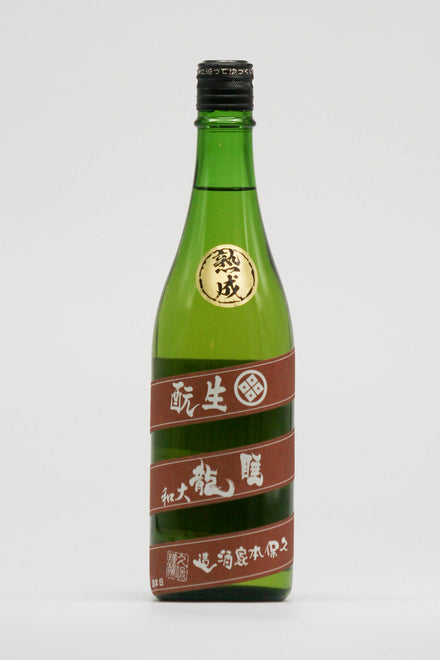

Tenju Sake Brewery is a producer of matured sake that retains the gorgeous aroma of Ginjo while adding complexity and depth through low-temperature aging. Through consultation with the brewery, Mr.Ueno of Sakematured.com selects a special bottle from the many past vintages. This product is only available via Sakematured.com.
Tenju Junmai Ginjo 1997
| Vintage | 1997 |
| Years aged | 25 years |
- 10 years or more
- 10,000 – 49,999yen
- 1990-1999
- All Products
- Light Yellow/Green
- Throughout the meal
- 熟と燗オリジナル
- Brewer:
- Alcohol:17 degrees
- Volume:720ml
Couldn't load pickup availability
[ Drinking alcohol under the age of 20 is prohibited by law. ]
Junmai Ginjo sake brewed with new equipment (OS tank*) in 1997.
A wonderfully balanced vintage with a blend of matured and ginjo aromas, and the depth of flavor added by maturing. This sake is delicious at room temperature or warmed.
A new world opens up when you warm it up a little to 45℃ for hot pot dishes.
*The bottom of the OS tank has a hemispherical shape that facilitates natural convection, and has a double structure that allows cooling water to be poured around it. It is possible to brew high quality sake with easy temperature control.
- about
-
Type 純米吟醸 Rice polishing ratio 53% Yeast type Association No. 9 Ingredients/raw materials Rice (domestic), rice malt (domestic) Rice type Yamada Nishiki Origin of rice Hyogo prefecture Toji(Brew Master) Yoshio Murakami Assemblage 無
- Recommended occasions/temperature
-
- How to store
-
- Delivery dates and charges
-


Tasting comments
-
Nobuhiro Ueno
(Juku to Kan Bar Master / Permanent Director of the Toki Sake Association)A mix of the scent of whitish flowers, the gentle scent of wild lilies, and the scent of mushrooms. A gentle attack but in a good way. In the mouth, it really surprises you with a strong flavor. As well as the above-mentioned aroma, the retronasal aromas include dried apricots and astragalus, which make for a very pleasant palate. The sweetness, umami, sourness, and astringency are well-balanced, and the aftertaste is long, inviting you to take a second or third sip. You can best feel its potential by starting with it chilled and then enjoying the change in flavor as the temperature rises.
-
Hidekazu Ishiwata
(Former National Tax Bureau Chief Appraiser)It has a beautiful aged aroma, a consistent aroma, and a hint of ginko.
Smooth texture. Compared to the aroma, the taste feels younger.
It has a sharp taste, but a lingering aftertaste. -
Akiko Toda
(Director of ITTEKI, Japan Sake and Meat Research Institute)Very smooth and pleasant to drink. The sweetness and sourness are well balanced, and the bitterness is not overpowering, giving it a rounded and gentle aftertaste that lasts for a long time.
-
Yuji Yamauchi
(Yushima Tenjinshita Sushi Hatsu 4th generation / 1st JSA SAKE DIPLOMA competition winner)In addition to the aroma of black tea and laurel, it also has a woody aroma and a fullness.
With a mid-palate that is rice-focused, it has a layered softness that is very well balanced throughout, so that it is never too heavy. It has a good lingering finish and balances purity and gentleness.
Brewer
- Choosing a selection results in a full page refresh.
- Opens in a new window.



